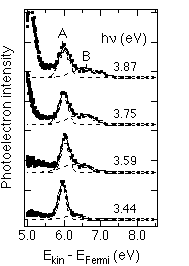

 |
 |
Comp Chem Research Developments | |
| Archive of Comp Chem Research News | |
January 12, 2000
|
||
|
||
|
Thiolate self-assembled monolayers (SAMs) on metal surfaces have been explored recently to address the assembly and connection issue in molecular electronics. A key question is: Is the interface conducting? A successful collaboration between the experimental group of Professor Xiaoyang Zhu (Postdoc Tom Vondrak and Graduate Student Hanfu Wang) and the theoretical group of Professor Chris Cramer (Graduate Student Paul Winget) has, for the first time, provided an answer to this question. These researchers probed the interfacial electronic structure, particularly unoccupied electronic states, in thiolate SAMs on Cu(111) using laser two-photon photoemission spectroscopy, in conjunction with ab initio calculations. They find that the interfacial electronic structure is dominated by two s* orbitals (LUMO and LUMO+1) localized to the C-S-Cu anchor and strongly coupled to the metal substrate. The shapes and energies of these interfacial s* orbitals are independent of the nature of the hydrocarbon group (conjugated aromatics or saturated alkyls). The implication of this finding for self-assembled molecular electronics is that, while thiolate contacts are conducting for conjugated molecular wires when the HOMO is important, they can be insulating for long molecular wires when conduction requires accessing the LUMO. |
||
 Two-photon photoemission spectra from a SAM of C6H5S/Cu(111). The two peaks originate from LUMO and LUMO+1 molecular orbitals shown at right. |
 HOMO, LUMO, and LUMO+1 molecular orbitals for copper(I) thiophenolate (left, A, C, E) and copper(I) propanethiolate (right, B, D, F). |
|
This work has been submitted for publication in the Journal of the American Chemical Society. A related paper is coming out in the Journal of Physical Chemistry B. |
||
|
| ||